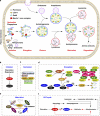The Beclin 1 network regulates autophagy and apoptosis
- PMID: 21311563
- PMCID: PMC3131912
- DOI: 10.1038/cdd.2010.191
The Beclin 1 network regulates autophagy and apoptosis
Abstract
Beclin 1, the mammalian orthologue of yeast Atg6, has a central role in autophagy, a process of programmed cell survival, which is increased during periods of cell stress and extinguished during the cell cycle. It interacts with several cofactors (Atg14L, UVRAG, Bif-1, Rubicon, Ambra1, HMGB1, nPIST, VMP1, SLAM, IP(3)R, PINK and survivin) to regulate the lipid kinase Vps-34 protein and promote formation of Beclin 1-Vps34-Vps15 core complexes, thereby inducing autophagy. In contrast, the BH3 domain of Beclin 1 is bound to, and inhibited by Bcl-2 or Bcl-XL. This interaction can be disrupted by phosphorylation of Bcl-2 and Beclin 1, or ubiquitination of Beclin 1. Interestingly, caspase-mediated cleavage of Beclin 1 promotes crosstalk between apoptosis and autophagy. Beclin 1 dysfunction has been implicated in many disorders, including cancer and neurodegeneration. Here, we summarize new findings regarding the organization and function of the Beclin 1 network in cellular homeostasis, focusing on the cross-regulation between apoptosis and autophagy.
© 2011 Macmillan Publishers Limited
Figures



References
-
- Tooze SA, Yoshimori T. The origin of the autophagosomal membrane. Nat Cell Biol. 2010;12:831–835. - PubMed
-
- Nishida Y, Arakawa S, Fujitani K, Yamaguchi H, Mizuta T, Kanaseki T, et al. Discovery of Atg5/Atg7-independent alternative macroautophagy. Nature. 2009;461:654–658. - PubMed
-
- Scarlatti F, Maffei R, Beau I, Codogno P, Ghidoni R. Role of non-canonical Beclin 1-independent autophagy in cell death induced by resveratrol in human breast cancer cells. Cell Death Differ. 2008;15:1318–1329. - PubMed
Publication types
MeSH terms
Substances
Grants and funding
LinkOut - more resources
Full Text Sources
Other Literature Sources
Medical
Research Materials

